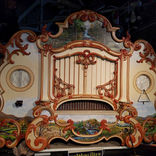
Band Organs
The Soul of the Carousel
Imagine riding a merry-go-round without music, or some other form of music that isn't the thunderous, infectious sound of a band organ. As you spin around and around, the merry strains of a march or waltz fade in and out as your steed races by the pipes and percussion belting out a tune. A carousel without a live band organ, regardless of the horses, carvings, paintings or anything else shall always be incomplete - after all, every heart needs a soul!
Band Organs and their music
The Wurlitzer 165 is often considered America's favorite carousel organ, and why wouldn't it be? The organ is extremely versatile in registration, percussion and has a range of notes making almost any piece of music possible to arrange. It sports a magnificent facade with intricate carved ornaments, paintings, and swell shutters adding further expression to the already great creative potential in registration.
To date, there are 11 known Wurlitzer 165s in existence, 3 of which are still in public view.
The Wurlitzer 157 was Wurlitzer's answer to the changing music tastes of the Roaring 20's. These are a half octave higher in pitch than the Wurlitzer 165 and have a characteristic sound with its clarinets and several ranks of violins - likely inspired by French Gavioli organs. It excels at playing popular fox-trots and has an impressive range with the top 2 trombones an octave lower than the others. There are very few examples left of this rare organ, only 4 remaining in original condition.
The Wurlitzer 153 is the most common style of organ on any American carousel. With its attractive facade featuring ornate carvings, paintings and in many cases lights, just looking at it gives reason for its immense popularity! The brilliant sound of the organ is due to its bright array of pipework, cleverly packed in its case to fit inside the center of a carousel.
Learn more about Wurlitzer 153 Band Organs in this blog post.
Another American manufacturer of band organs was Artizan Factories. Lasting only through the 20's, this firm produced a variety of pressure-operated organs.
On Left: This organ was converted by Artizan to rolls from pinned barrels and has a bright, peppy sound. The music playing is from the B.A.B organ company which continued to make Artizan music into the 50's.
On Right: One of a handful of Artizan XA-1 band organs, this one residing at the DeBence Museum in Franklin PA. The organ showcases Artizan's skilled pipe design having robust wooden trumpets.



German fairground organs are prolific at playing marches, waltzes, and overtures arguably over any other type of organ. Their powerful, commanding presence can be attributed to their construction with mixture pipes playing several different harmonics and the unique style of arranging for them using strident accents and chording in the wood trumpet pipes designed to simulate a German military band.
The 'Berni organ' is a Gebruder Bruder style 107 which plays alongside the Kremer carousel at Knoebels Amusement Resort in Elysburg, PA. Imported by Louis Berni: dubbed the 'band organ king', (though this firm was only an importer, not a builder) this is one of many German and French band organs brought to the US, coming here in the days before Wurlitzer took over the American market.
This next organ is a style 33-A Ruth, a roll-playing organ with a rare duplex roll system. Last is an example of a style 38 Ruth. In the early days, these could be found in elegant beer gardens and traveling shows through Europe. Moving figures and elaborate baroque carvings made these fine works of visual excellence as well as in sound. Pictured below are other examples of fine German organs.

The sound of a French organ can be more compared to that of an orchestra rather than a military band. Coming in many shapes and sizes, the tone of most instruments from this region are considerably more mellow with a bigger dependence on lower reed pipes and orchestral sounding violins and clarinets than their German counterparts. Firms such as Gavioli, Limonaire, Marenghi, and Gaudin made these instruments, the majority of production lasting through the first World War. The largest of these traveled with showmen and accompanied bioscope shows during the turn of the century: a craze that went away almost as soon as it came, but the organs endured!
The organ figure to the left is conducting an 89 key Gavioli which travels to many band organ rallies across the United States. Beautifully restored, this is quite the marvel to see in person! Below is a 57 Key Gavioli, characteristic in it's lifelike piccolos and clarinets,

This next organ is an 114 key Gaudin. Organs such as this were intended for dance halls and could simulate the sound of many different instruments. With such a massive scale, most of a band score could be put into the music without changing much at all!
Brass trumpet band organs, unlike most other instruments on this page were originally intended for roller skating rinks rather than carousels. In the early 20th century, roller skates used wooden wheels and the sound could be almost deafening! Music somehow had to be louder, so depending on the size of a rink, an appropriately sized trumpet band organ was generally purchased. Regardless of volume, the sound of a trumpet band organ can be absolutely magnificent simulating the sound of an all-American brass band!
On the right is a Wurlitzer 148 which often travels to band organ rallies across the United States. The organ plays American marches splendidly and other later music well. You can almost imagine skating in time to a waltz or fox-trot, not so much with a march!


On the left is a closeup of the Wurlitzer 175, this being the only example of this model to have been built. The design of this facade, certainly inspired by an earlier Gavioli organ later became the Wurlitzer 180: Wurlitzer's largest band organ.









